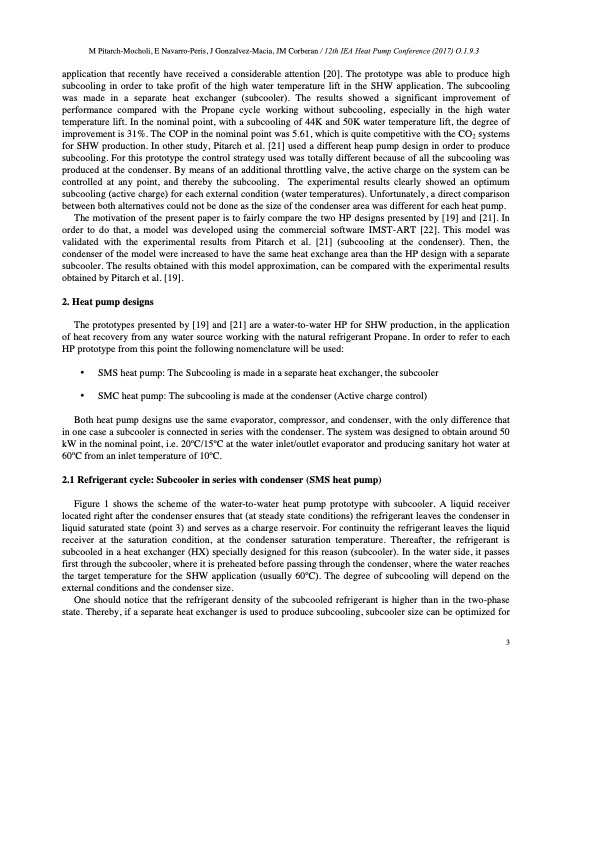
PDF Publication Title:
Text from PDF Page: 003
M Pitarch-Mocholi, E Navarro-Peris, J Gonzalvez-Macia, JM Corberan / 12th IEA Heat Pump Conference (2017) O.1.9.3 application that recently have received a considerable attention [20]. The prototype was able to produce high subcooling in order to take profit of the high water temperature lift in the SHW application. The subcooling was made in a separate heat exchanger (subcooler). The results showed a significant improvement of performance compared with the Propane cycle working without subcooling, especially in the high water temperature lift. In the nominal point, with a subcooling of 44K and 50K water temperature lift, the degree of improvement is 31%. The COP in the nominal point was 5.61, which is quite competitive with the CO2 systems for SHW production. In other study, Pitarch et al. [21] used a different heap pump design in order to produce subcooling. For this prototype the control strategy used was totally different because of all the subcooling was produced at the condenser. By means of an additional throttling valve, the active charge on the system can be controlled at any point, and thereby the subcooling. The experimental results clearly showed an optimum subcooling (active charge) for each external condition (water temperatures). Unfortunately, a direct comparison between both alternatives could not be done as the size of the condenser area was different for each heat pump. The motivation of the present paper is to fairly compare the two HP designs presented by [19] and [21]. In order to do that, a model was developed using the commercial software IMST-ART [22]. This model was validated with the experimental results from Pitarch et al. [21] (subcooling at the condenser). Then, the condenser of the model were increased to have the same heat exchange area than the HP design with a separate subcooler. The results obtained with this model approximation, can be compared with the experimental results obtained by Pitarch et al. [19]. 2. Heat pump designs The prototypes presented by [19] and [21] are a water-to-water HP for SHW production, in the application of heat recovery from any water source working with the natural refrigerant Propane. In order to refer to each HP prototype from this point the following nomenclature will be used: • SMS heat pump: The Subcooling is made in a separate heat exchanger, the subcooler • SMC heat pump: The subcooling is made at the condenser (Active charge control) Both heat pump designs use the same evaporator, compressor, and condenser, with the only difference that in one case a subcooler is connected in series with the condenser. The system was designed to obtain around 50 kW in the nominal point, i.e. 20oC/15oC at the water inlet/outlet evaporator and producing sanitary hot water at 60oC from an inlet temperature of 10oC. 2.1 Refrigerant cycle: Subcooler in series with condenser (SMS heat pump) Figure 1 shows the scheme of the water-to-water heat pump prototype with subcooler. A liquid receiver located right after the condenser ensures that (at steady state conditions) the refrigerant leaves the condenser in liquid saturated state (point 3) and serves as a charge reservoir. For continuity the refrigerant leaves the liquid receiver at the saturation condition, at the condenser saturation temperature. Thereafter, the refrigerant is subcooled in a heat exchanger (HX) specially designed for this reason (subcooler). In the water side, it passes first through the subcooler, where it is preheated before passing through the condenser, where the water reaches the target temperature for the SHW application (usually 60oC). The degree of subcooling will depend on the external conditions and the condenser size. One should notice that the refrigerant density of the subcooled refrigerant is higher than in the two-phase state. Thereby, if a separate heat exchanger is used to produce subcooling, subcooler size can be optimized for 3PDF Image | Comparative analysis of two subcritical heat pump boosters using subcooling

PDF Search Title:
Comparative analysis of two subcritical heat pump boosters using subcoolingOriginal File Name Searched:
subcritical-heat-pump-boosters.pdfDIY PDF Search: Google It | Yahoo | Bing
CO2 Organic Rankine Cycle Experimenter Platform The supercritical CO2 phase change system is both a heat pump and organic rankine cycle which can be used for those purposes and as a supercritical extractor for advanced subcritical and supercritical extraction technology. Uses include producing nanoparticles, precious metal CO2 extraction, lithium battery recycling, and other applications... More Info
Heat Pumps CO2 ORC Heat Pump System Platform More Info
| CONTACT TEL: 608-238-6001 Email: greg@infinityturbine.com | RSS | AMP |